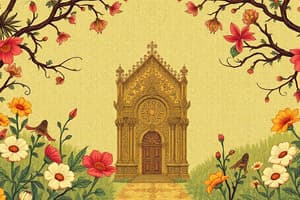Podcast
Questions and Answers
What distinguishes Serif fonts from Sans Serif fonts?
What distinguishes Serif fonts from Sans Serif fonts?
- Serif fonts incorporate fancy lines. (correct)
- Serif fonts have no lines at all.
- Both fonts are identical in appearance.
- Sans Serif fonts have decorative elements.
Which of the following are raster image formats?
Which of the following are raster image formats?
- PNG-24 and GIF (correct)
- JPEG and SVG
- SVG and EPS
- AI and BMP
What does the RGB color model primarily do?
What does the RGB color model primarily do?
- Produce images with lower resolution.
- Add colors by mixing three base colors. (correct)
- Render subtractive color outputs.
- Create grayscale images.
Which of the following is NOT a principle of design?
Which of the following is NOT a principle of design?
What is emphasized in the 'rule of thirds' in visual composition?
What is emphasized in the 'rule of thirds' in visual composition?
What does the acronym 'dpi' represent in image resolution?
What does the acronym 'dpi' represent in image resolution?
Which tool would you use to eliminate red-eye in photos?
Which tool would you use to eliminate red-eye in photos?
What is the primary function of bitmap tracing?
What is the primary function of bitmap tracing?
Which of the following tools helps to create smooth lines and curves?
Which of the following tools helps to create smooth lines and curves?
Identify the tool used for making quick selections in an image.
Identify the tool used for making quick selections in an image.
Flashcards are hidden until you start studying
Study Notes
Difference Between Serif and Sans Serif
- Serif fonts have decorative lines or embellishments at the ends of their strokes, while Sans Serif fonts lack these features.
Types of Images
- Raster Images: Composed of pixels, examples include:
- GIF
- PNG-8
- PNG-24
- JPEG
- BMP
- TIFF
- RAW/CIFF
- Vector Images: Made up of paths defined by mathematical equations, examples include:
- SVG
- AI
- EPS
Seven Elements of Art
- Shape
- Form
- Line
- Color
- Value
- Space
- Texture
Principles of Design
- Movement
- Emphasis: Directing attention to focal points
- Harmony
- Variety
- Balance
- Contrast
- Proportion
- Pattern
- Unity
Primitives
- Basic three-dimensional geometric shapes forming the foundation for complex geometric objects.
Raster vs. Vector Images
- Raster Images: Made of dots or pixels.
- Vector Images: Composed of lines, curves, and fills.
RGB Color Model
- Primarily used for screen displays by blending red, green, and blue, the three primary colors of light.
Subtractive Color Models
- CMYK (Cyan, Magenta, Yellow, Black) and LAB* (also includes additive elements).
Emphasis
- Techniques to highlight an object, such as increasing size, brightness, repetition, or movement.
Rule of Thirds
- A composition guideline that divides an image into nine equal sections, placing focal points at the intersections for balanced visuals.
DPI
- Stands for "dots per inch," a measure of image resolution.
Bitmap Tracing
- The process of converting raster images into vector formats.
Photoshop Tool Identification
- Familiarize with the following tools by their icons:
- Smudge Tool
- Healing Brush Tool
- Ellipse Tool
- Red Eye Tool
- Magic Wand Tool
- Clone Stamp Tool
- Spot Healing Brush Tool
- Hand Tool
- Burn Tool
- Quick Selection Tool
- Patch Tool
- Brush Tool
- Lasso Tool
- Zoom Tool
- Freeform Pen Tool
- Gradient Tool
- Move Tool
- Delete Anchor Point Tool
- Horizontal Type Tool
- Magic Eraser Tool
- Vertical Type Tool
- Direct Selection Tool
- Paint Bucket Tool
Studying That Suits You
Use AI to generate personalized quizzes and flashcards to suit your learning preferences.




